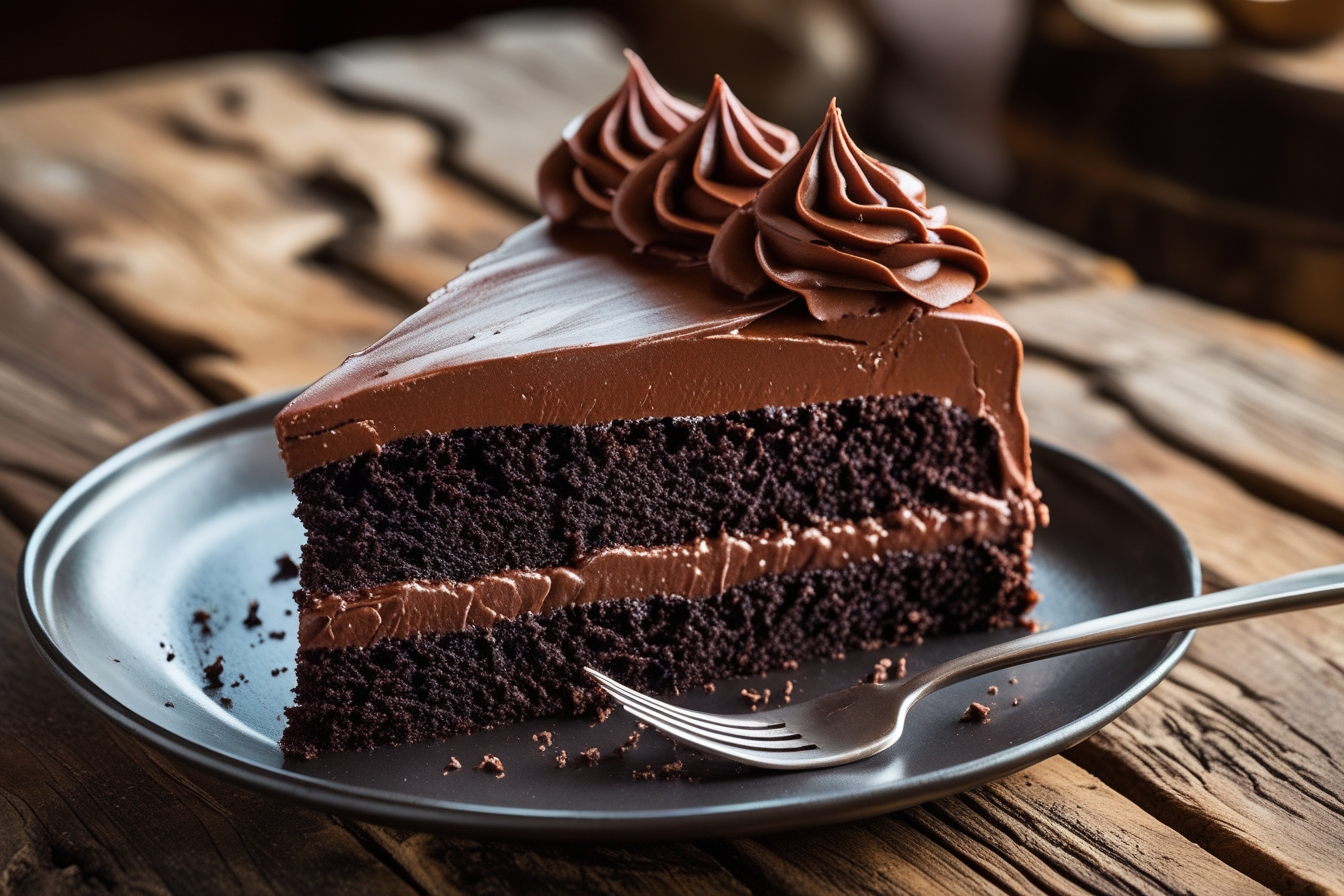Matilda cake, a decadent and unforgettable dessert inspired by the iconic movie scene, has captured the hearts of chocolate lovers everywhere. With its rich, fudgy layers and indulgent frosting, it’s no wonder people are curious about its caloric content. But how many calories are in a slice of Matilda cake? This article dives into the specifics, comparing recipes, analyzing ingredients, and offering healthier ways to enjoy this guilty pleasure.
Understanding Matilda Cake and Its Caloric Content
What Is Matilda Cake?
Few cakes are as legendary as Matilda cake. Born from the iconic scene in Roald Dahl’s “Matilda,” this dessert epitomizes indulgence. Thick, velvety layers of chocolate cake, topped with creamy frosting, make it a standout treat for celebrations or cravings alike.
Origin and Popularity
The cake gained fame when it starred in the memorable scene where Bruce Bogtrotter faces a massive slice in the film adaptation. Over the years, fans have recreated this luscious dessert, cementing its place in the world of decadent cakes.
Typical Ingredients Used
Traditionally, Matilda cake includes ingredients like cocoa powder, butter, sugar, flour, and eggs. Additions like heavy cream and chocolate ganache elevate its texture and taste. Sometimes, bakers incorporate vanilla extract or coffee to enhance the flavor depth.
Importance of Knowing Caloric Content
Health and Dietary Considerations
While Matilda cake is undeniably delicious, it’s also calorie-dense. Knowing how many calories are in a slice can help balance indulgence with dietary goals. Whether you’re counting calories for weight management or simply making informed choices, awareness is key.
Portion Control and Informed Choices
Portion control matters, especially with rich desserts like this one. After all, even a smaller slice can be satisfying without overloading on sugar or fat. Making informed decisions empowers you to enjoy the cake without guilt.
Detailed Caloric Analysis
Average Calories per Slice
Standard Serving Size Definition
A standard serving size for Matilda cake typically measures around one-eighth of a full 9-inch cake. While recipes vary, this slice usually weighs between 150 to 200 grams. Such a portion is enough to satisfy a sweet tooth without overindulging—though we all know how tempting a second helping can be!
Caloric Range Based on Recipes
On average, a single slice of Matilda cake contains between 450 and 650 calories. Why such a wide range? The caloric content depends on the recipe’s richness. For example, a slice heavy on butter, sugar, and cream will naturally lean toward the higher end of the spectrum. However, lighter variations with reduced sugar or oil substitutes may dip below 500 calories.
Factors Influencing Caloric Content
Ingredient Variations
The ingredients play a pivotal role in determining how many calories are in a slice of Matilda cake. Standard recipes use full-fat butter, sugar, and cocoa, all of which contribute to its high calorie count. Substituting butter with applesauce or sugar with natural sweeteners can significantly lower the overall caloric value.
Preparation Methods
Did you know that the way a cake is prepared affects its calories? For instance, cakes baked with richer frostings or layered with chocolate ganache contain more calories than single-layered versions. Moreover, using whipped toppings instead of dense frosting could shave off a significant number of calories.
How Does Matilda Cake Compare?
Caloric Content of Popular Chocolate Cakes
Standard Chocolate Cake
A classic chocolate cake slice, without extra fillings or frostings, typically contains around 350-400 calories. It’s simpler but less indulgent compared to Matilda cake.
Fudge Chocolate Cake
Known for its dense texture and rich flavor, fudge chocolate cake rivals Matilda cake with a calorie count ranging between 500 and 600 calories per slice.
Flourless Chocolate Cake
Flourless chocolate cakes are a slightly different beast. High in fat due to the use of almond meal or pure chocolate, they average about 450 calories per smaller serving.
Nutritional Differences
Fat Content
Matilda cake tends to have higher fat content due to its butter-rich layers and frosting. On the other hand, standard chocolate cakes use less butter, keeping the fat levels slightly lower.
Sugar Levels
It’s no surprise that Matilda cake packs in more sugar compared to simpler cakes. With its heavy frosting and dense batter, it contains at least 30% more sugar than most traditional cakes.
Presence of Additional Ingredients (e.g., Nuts, Cream)
Additions like nuts or a dollop of cream can raise the calorie count even further. These ingredients not only boost the dessert’s richness but also add nutritional value—albeit at the cost of extra calories.
Understanding the Impact
Short-Term Effects
Blood Sugar Levels
Consuming a calorie-heavy slice of Matilda cake can cause a significant spike in blood sugar levels. The combination of refined sugar and simple carbohydrates rapidly enters the bloodstream, providing a quick boost of energy. Unfortunately, this surge is often followed by a steep drop, leaving you feeling sluggish or even hungry sooner than expected.
Energy Spikes and Crashes
Ever felt a sudden burst of energy after dessert? That’s the sugar talking. While this temporary energy surge might seem beneficial, it often leads to an inevitable crash. This rollercoaster effect can leave you feeling fatigued and irritable, especially if paired with a sedentary lifestyle.
Long-Term Health Considerations
Weight Gain
Regularly indulging in high-calorie treats like Matilda cake contributes to excess caloric intake. When these additional calories aren’t burned off, they get stored as fat, leading to weight gain over time. It’s a simple case of “calories in versus calories out,” but moderation is key.
Risk of Chronic Diseases
Frequent consumption of calorie-dense foods increases the risk of chronic conditions, including Type 2 diabetes, heart disease, and obesity. The high sugar content in desserts like Matilda cake can lead to insulin resistance, while saturated fats raise cholesterol levels. Being mindful of your intake can mitigate these risks.
Enjoying Treats Mindfully
Portion Control Strategies
Sharing Servings
Sometimes, all you need is a taste. Share a slice of Matilda cake with a friend or family member to cut your calorie intake in half without missing out on the experience. Plus, sharing adds a touch of joy to the indulgence!
Using Smaller Plates
Believe it or not, serving size perception plays a significant role in how much we eat. By using smaller plates or bowls, your portion looks more substantial, helping you feel satisfied with less.
Healthier Ingredient Substitutions
Reducing Sugar Content
Swap out a portion of the refined sugar with alternatives like stevia or monk fruit sweetener. These options maintain sweetness without adding empty calories, making your slice of Matilda cake just as delicious but lighter on the waistline.
Using Whole Grain Flours
Replacing all-purpose flour with whole grain or almond flour adds fiber and reduces the glycemic impact. This change not only cuts calories but also makes the cake more filling.
Incorporating Natural Sweeteners
Add sweetness with natural ingredients like mashed bananas or unsweetened applesauce. These substitutes enhance flavor while lowering the overall calorie count, making the cake a slightly healthier indulgence.
Frequently Asked Questions
How many calories are in a Matilda cake slice?
A typical slice of Matilda cake contains approximately 450 to 650 calories, depending on the recipe and portion size.
How many calories are in the average slice of cake?
The average slice of cake ranges from 300 to 400 calories without frosting, but this can increase with rich layers or additional toppings.
How many calories are in Parker’s Matilda cake?
Parker’s Matilda cake is known for its indulgent ingredients and averages around 550 to 700 calories per slice.
How many calories are in a slice of cake with frosting?
A slice of cake with frosting generally contains 350 to 600 calories, influenced by the type of cake and the richness of the frosting.
Making Informed Choices About Indulgent Desserts
Balancing Enjoyment and Health
Importance of Moderation
Indulging in desserts like Matilda cake doesn’t have to derail your health goals. The key lies in moderation. Savoring a slice occasionally, rather than regularly, allows you to enjoy its richness without overloading on calories. Treat it as a special reward instead of a daily habit, and you’ll find that even small portions can feel incredibly satisfying.
Incorporating Physical Activity
Burning off the calories from a slice of Matilda cake is easier when paired with physical activity. Whether it’s a brisk walk, a yoga session, or a gym workout, exercise can balance out occasional indulgences. Not only does it help with calorie management, but it also keeps you feeling energetic and healthy.
Final Thoughts on Matilda Cake’s Caloric Content
Matilda cake represents more than just a dessert—it’s an indulgent experience. While a slice can be calorie-dense, awareness of its nutritional content empowers you to make informed decisions. By combining mindful portion control, healthier ingredients, and regular physical activity, you can enjoy this iconic treat without guilt.
Ultimately, life’s too short to skip dessert entirely. So go ahead and relish your slice of Matilda cake—just remember, balance is the ultimate recipe for happiness and health.

